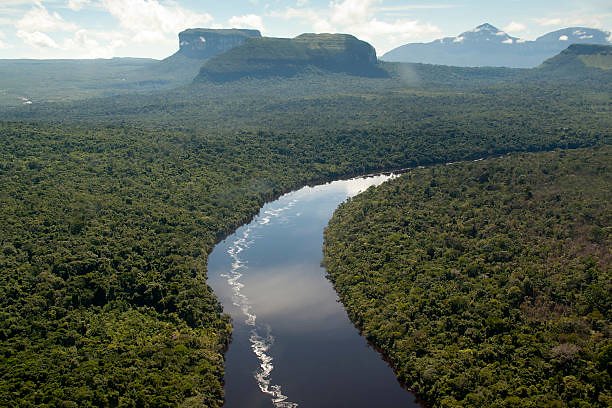
Interest in botanical exploration in the Guayana region dates back to the 18th century; specifically to the year 1754, when Pehr Löfling, a Swedish botanist, led the first botanical expedition to the region with the purpose of locating plants of economic value (Texera 1991) and botanically exploring the Lower Caroní area (Huber 1995a). Eugenio Alvarado, another member of this expedition, took notes on the vegetation and some economically important plants of the Lower Orinoco, among which they found representatives of cinchona, carob and carapa (Huber 1995a). He was followed by the naturalist Alexander von Humboldt and the botanist Aimé Bonpland, who worked in the Middle and Upper Orinoco, reaching the mouth of the Caño Iguapo. The quantity and quality of the information collected by these two researchers during their exploration in the Guayana region is valuable and is still considered important for scholars of Venezuelan botany (Huber 1995a). Later came the geographers Richard and Robert Schomburgk who were the first to collect in the Roraima-tepui. Botanist Richard Spruce also visited the Guiana region, exploring in the Amazon (Huber 1995a).
At the end of the 19th century, explorers came interested in studying the Tepuyan peaks, never before botanically sampled. That is why in the middle of this century numerous North American botanists carried out explorations in this region, among whom Bassett Maguire and Julian Steyermark (Texera 1991) stand out.
Although the aforementioned explorations excluded the study area of this investigation, during the years 1920 to 1921, Liberty Hyde Bailey and his wife visited Ciudad Bolívar, but did not deposit samples in the country (Texera 1991), doing so in the GH herbaria (Universidad Harvard), BH (Cornell University) and NY (New York Botanical Garden).
In 1943 the botanist Ellsworth P. Killip of the U.S. National Herbarium (US), invited by Henri Pittier and the Ministry of Agriculture and Livestock (MAC), collected near Ciudad Bolívar, managing to gather some 500 specimens. The collection is deposited at VEN and US (Huber 1995a). Later, in 1946, the Venezuelan botanists Francisco Tamayo and Tobías Lasser, from the Ministry of Agriculture and Breeding (MAC), collected between Ciudad Bolívar and Caicara del Orinoco, compiling more than 600 samples, which considerably increased the knowledge of the savannahs of Guyana (Huber 1995a).
Other agencies such as the Ministry of Public Works and the Ministry of the Environment and Natural Resources (MARN) carried out studies in the Guayana region starting in 1969, including forest inventories and ecological observations, while providing logistical support for many botanical expeditions. that took place in the mentioned region.
In 1985, the Venezuelan Corporation of Guayana (CVG), through its subsidiary Técnica Minera C.A. (CVG-TECMIN), carried out botanical exploration works within the Inventory Project of Natural Resources of the Guayana Region. The purpose of this work was to make these resources known and to present the information on a large scale (Sanoja 1994). Unfortunately, the investigations did not leave reference collections for the study area.
Mainly due to the lack of scientific information, and the creation of floristic research development plans in the Guayana region and in particular the Ciudad Bolívar area, the Orinoco Botanical Garden Foundation (FJBO) was created in 1992. In order to meet the demands and goals proposed by the FJBO, the results of the first investigations are beginning to be disclosed. In 1995, Prof. Leandro Aristeguieta, president of the FJBO at the time, carried out an inventory of the trees of Ciudad Bolívar, considering both the cultivated species and those that are wild (indigenous) in the natural areas of Ciudad Bolívar (Aristeguieta 1995). In this work, 194 tree species are reported, with information on uses in general and usefulness for ornamentation and tree planting in the city.
Another of the preliminary contributions of the investigative management of the FJBO is that of Salazar & Mata (1995), who carried out an inventory of the species of dicotyledons of non-arboreal habit that grow in the area of the FJBO.
Caraballo (1995) completes the inventory of the monocot species that grow in the localities of the FJBO. More recently, Díaz & Rosales (2006) collected in the study area as part of the investigation on the flora and vegetation prone to flooding in the riparian corridor of the lower Orinoco River. Likewise, Delascio & Díaz (2005) sampled in Ciudad Bolívar and its surroundings in their work on the Morichales of this area.
Source of potential plagiarism
Direct translation without giving credit to the original author is Plagiarism. Repeated plagiarism is considered fraud. Fraud is discouraged by the community and may result in the account being Blacklisted.
Guide: Why and How People Abuse and Plagiarise
Please note that direct translations including attribution or source with no original content are considered spam.
If you believe this comment is in error, please contact us in #appeals in Discord.
I do not consider it plagiarism since my 76-year-old uncle was part of this expedition and helped write the article on the investigation of biodiversity in this area, he is a professor of botany at the UCV University in Caracas Venezuela. The original author allows the information to be shared without any problem since it was written by several people, so you should ask next time before making sure of something. Thank you.